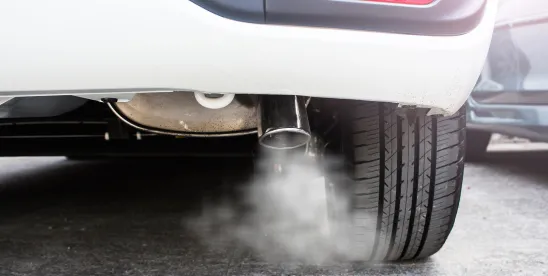For decades, California has been granted unique deference in setting Clean Air Act (CAA) emissions limitations for California-sold vehicles through use of a state-specific waiver.
California’s state-specific waiver allows the state to impose stricter emission standards than those issued at the federal level. In recent years, California has aggressively used this state-specific waiver to target greenhouse gas emissions and mandate a shift toward electric vehicles (EVs). This approach has been controversial and — unsurprisingly — led to litigation as product manufacturers of all kinds factor in California regulatory particularities in determining their nationwide mix of products.
We have chronicled recent, though frequent, push-and-pull between states like California seeking stricter environmental controls and others favoring less regulations. (e.g.,here and here.) And if you have been following the ongoing saga of state-led climate regulation, the US Supreme Court’s new decision in Diamond Alternative Energy, LLC v. EPA is a must-read. It addresses environmental policy, federalism, and the question of who gets to challenge government action in court. Below, we break down what happened and why it matters to the regulated community.
CAA and California’s Climate Ambitions
California has long been the nation’s laboratory by enacting aggressive vehicle emissions standards. Under the CAA, the US Environmental Protection Agency (EPA) sets nationwide emissions rules for new cars, but it allows California, as a result of US Congress recognizing its unique air quality challenges like smog, to seek a waiver to impose stricter CAA standards. Other states can then choose to adopt California’s rules but are not permitted by CAA to unilaterally create their own rules in the same manner as does California. The rules, as currently in effect, require automakers to sell more EVs and limit average greenhouse gas emissions across their fleets. As of now, 17 other states and Washington, DC, have followed California’s lead, together representing about 40% of the buyers in the US auto market.
The Legal Challenge: Who Gets to Sue?
Enter the fuel producers — companies that make and sell gasoline, diesel, and ethanol. Before the Court, fuel producers argue that California’s rules, by reducing the number of gas-powered cars on the road in favor of EVs which can meet California’s requirements, directly hurt their bottom line because less demand for gasoline means less revenue. The litigation focuses on EPA’s approval of California state-specific waiver, claiming the agency overstepped its authority by greenlighting state rules aimed at global climate change rather than addressing local air quality.
As with many challenges, before reaching the merits, reviewing courts needed to determine if fuel producers had standing to sue. Legal standing requires plaintiffs to show that they have suffered a concrete injury, that the injury is caused by the challenged action and that a favorable court decision would likely redress that injury. “Injury in fact,” causation, and redressability are often referred to as the three prongs of standing analysis. The Supreme Court frequently reviews standing. Last term, the Court reviewed the organizational standing case FDA v. Alliance for Hippocratic Medicine (for more, see here).
The Court’s Decision
The DC Circuit Court of Appeals determined that the challengers lacked standing because they depended on claims that automakers could have asserted but did not pursue. It reasoned that even if it struck down EPA’s approval of California’s rules, the holding might not lead automakers to actually build more gas-powered cars. After all, consumer demand for EVs is surging, and manufacturers have already invested heavily in electrification. Without clear evidence that the market would shift back toward gasoline vehicles, the court found the fuel producers’ alleged injury too speculative.
The Supreme Court, in a 7-2 decision authored by Justice Brett Kavanaugh, disagreed. The majority held that the fuel producers had standing to challenge EPA’s approval. Here is why:
- Injury in Fact: The Court found it “straightforward” that fuel producers are financially harmed by regulations designed to reduce gasoline consumption. Indeed, it noted that the point of the rules was to compel a transition away from gasoline-powered vehicles.
- Causation: It ruled that the link between California’s regulations and reduced fuel sales is direct. The regulations compel automakers to build more EVs and fewer cars that use gas or other liquid fuels, something that directly affects the fuel producers.
- Redressability: Here, the Court pushed back hardest against the circuit court’s decision. The majority reasoned that it’s “predictable,” based on common sense and the record, that if the regulations were invalidated, at least some automakers would build more gas-powered cars leading to more fuel sales. The Court emphasized that even a small increase in sales would satisfy the legal standard.
The Court also rejected the idea that plaintiffs must provide expert affidavits or direct evidence from automakers about how they would respond to regulatory changes. Instead, it noted that it is enough for plaintiffs to show a “predictable chain of events” based on economic logic and the government’s own statements about the regulations’ impact.
Practical Takeaways
This ruling is significant for several reasons:
- Broader Access to the Courts: The decision may lower the bar for industry plaintiffs to challenge environmental regulations, especially when they can show a direct economic impact — even if the market is complex and third-party behavior is involved. Justice Ketanji Brown Jackson’s dissent argues that the Supreme Court does not apply standing doctrine “evenhandedly” and notes that allowing petrochemical companies to sue here is inconsistent with precedent and “comes at a reputational cost for the Court, which is already viewed as being overly sympathetic to corporate interest.” Justice Jackson concluded that the Court should have refrained from deciding this case.
- Increased Regulatory Uncertainty: By allowing fuel producers to challenge EPA’s approval of California’s rules, the Court has injected new uncertainty into the future of state-led climate initiatives. If the fuel producers ultimately prevail on the merits, it could upend California’s (and other states’) ability to push the auto industry toward electrification of changing the kinds of cars they sell.
- A Signal to Agencies and States: The Court’s skepticism toward arguments that regulations are “irrelevant” because the market has already shifted should be taken as a warning to regulators. If an agency is still enforcing and defending a rule, do not expect courts to believe it has no real-world effect.
The Bottom Line
The decision did not determine whether California’s rules are lawful; that fight is ongoing in the courts, in Congress, and at EPA. But by clearing the way for fuel producers to have their day in court, the justices have set one stage for a high-stakes battle over the future of vehicle emissions regulation, the scope of state authority, and the role of courts in refereeing these disputes. For anyone monitoring the intersection of climate policy, industry, and the law, this is a case worth following.




 />i
/>i
